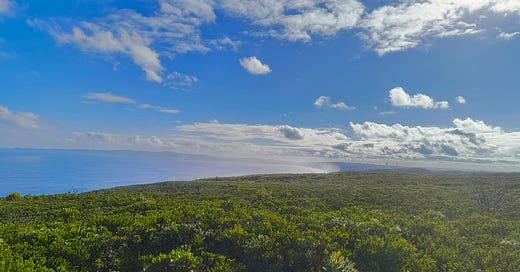Whale Song
Walking uphill, my pack heavy on my back. We had been walking for a few hours and had perhaps another two to go before reaching our shelter for the night. We had stopped for lunch half an hour previously, but it felt more like a snack than lunch. I was already looking forward to getting to camp and having a cuppa and more food, to taking this weight off my back. Ahead of me, my walking buddy chatted. The sound of it washed over me. Then I heard something else. “What was that?” I asked.
Judy stopped. Turned to look at me. “I didn’t hear anything,” she said.
“There,” I said. “Did you hear that?”
“Yes.”
We stood silently in the coastal scrub, high on the cliff, a dome of blue sky above us, a great expanse of bluer ocean below. There was no wind. No ruffles of white caps across the vastness of the ocean below. The sound came again, a long, low cry; almost mournful. Loud.
“It’s a whale!”
And there it was, lolling on the surface of the ocean tens of metres below us. The whoosh of spray as it breathed out through its blowhole. The cry as it called. The sound as big as the ocean. I imagined it reverberating out through the water as I heard it reverberating up through the air.
We stood mesmerised. Listening. Watching. Smiling; it was impossible not to. My pack no longer felt heavy.
It’s relatively common to see whales along this coast. Humpback whales migrate from summer feeding grounds near Antarctica in the southern ocean, north along the Australian coast, between June and August. Those that travel up the western coast have breeding grounds in the warmer waters off the northern Kimberley coast. From there, they travel back south between August and November. While travelling, they are generally within 200 metres of the coast, so high cliff tops make for good viewing. Southern right whales follow a similar pattern, a little later than the humpbacks.
The whale below us on the cliff that day was a humpback, as were those we saw on previous days during our multi-day hike. I’m familiar enough with them to be able to determine that much. The colouring, the shape, the behaviour - lots of fluke and tale waving, breaching.
But this song was new to me. I had never heard such a thing. I always thought whale songs were about mating, but this is a migration route not a breeding ground, so that doesn’t make sense.
Later, I did a bit of digging. It seems a lot of people have spent a lot of time listening to and analysing whale vocalisations. Researchers have likened humpback whale songs to human language, in that it follows patterns and is learned not innate. Songs differ and an individual whale may sing ever more complex melodies over time. But it is not considered to actually be language, in the sense of containing words and sentences, as beguiling as such an idea might be. Scientists differentiate between language-like and language.
Whale song is often considered to be a way of attracting mates - it’s the males that sing. The theory is that they do so to attract the females - serenading if you like. (I had thought this was the other way around, but apparently not.) Or to warn other males of their superiority and strength.
But what of ‘my’ whale calling from near the surface? The area isn’t a breeding ground. Not a mating song then. It was a singular sound, repeated every minute or so. Not really a melody.
As well as their songs, humpbacks make other sounds to communicate and to find each other. Sometimes during hunting they make a loud sound to push herring to the surface. My guess is that my whale was calling out to see if anyone else was around, or else he was having a feed of herring. But I don’t know for sure. All I really know is that it was a hauntingly beautiful sound.
We walked on, the whale song behind us. Around a bend and down a small incline the sound was lost to us. Silence enveloped us once again. We walked on quietly, hearts full. My pack felt lighter.
See you outside,
Jill




